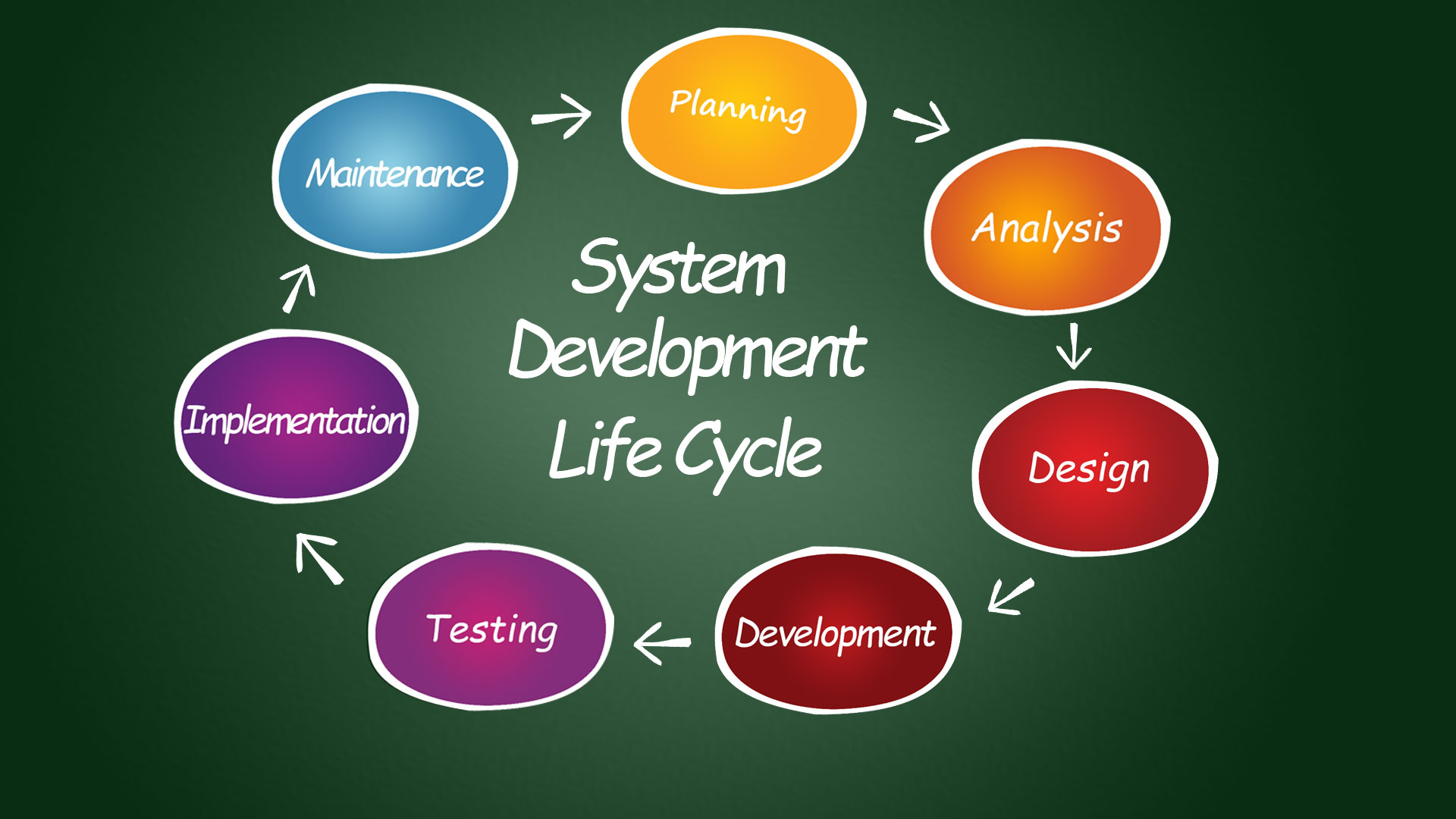-

What is Software Development Life Cycle?
The Software Development Life Cycle (SDLC) is a step-by-step framework for developing high-quality software quickly. It details how to plan, deploy, and maintain software while promoting quality and keeping costs down.
How Does the Software Development Life Cycle Work?
Software Development Life Cycle is the application of standard business practices to building software applications. It’s typically divided into six to eight steps: Planning, Requirements, Design, Building, Documenting, Testing, Deploying, and Maintaining. Some project managers will combine, split, or omit steps depending on the project’s scope.
Software Development Life Cycle is a way to measure and improve the development process. It helps companies maximize efficiency at each stage. As computing power increases, it places a higher demand on software and developers. Companies must reduce costs, deliver software faster, and match customers’ needs.
The Software Development Life Cycle outlines each task required to create a software application. This helps to reduce waste and increase the efficiency of the development process. Monitoring also ensures that the project stays on track and remains a viable investment for the company.
Phases of the Software Development Life Cycle
Phase 1: Evaluation and Discovery
The primary purpose of this step is to understand the end user. Keeping the user at the center gives you a clear vision and purpose for your project. It will help you define appropriate goals and scope for your project. Your team will gather information and insights to identify problems that need solving.
Phase 2: Planning
Project leaders evaluate the terms of the project, including the calculation of labor and material costs, to create a timetable with goals. Planning must also include areas of feedback from stakeholders or anybody who is going to benefit from the applications.
Phase 3: Defining Requirements
In this step, we clearly define and document the product requirements to meet the user’s needs. Then, we seek approval from the customer and other stakeholders. This is done through an SRS (Software Requirement Specification) document, which consists of all the product requirements to be designed and developed during the project life cycle.
Phase 4: Design and Prototyping
This phase determines the way a software application will work and some of its design aspects, including:
UI: How customers will interact with the software and how the software is meant to respond to specific inputs.
Programming: The programming language used and how the software will solve problems and perform tasks.
Security: Certain measures will be taken to ensure the application is secured. This includes SSL encryption, password protection, and secure data storage.
Communications: Define how the application will communicate with other assets, like a central server.
Architecture: Includes industry practices, templates, overall design, and specific programming languages.
Platforms: Outlines the platform that will host the software, like Apple, Windows, Android, or Linux.
Prototyping can be a part of the Design phase. A prototype is like one of the early software versions in the Iterative software development model. It demonstrates a basic idea of how the application looks and works. This prototype can be shown to stakeholders to obtain feedback for improving the application. It’s less expensive to change the prototype phase than to rewrite code to make a change in the later stages of the software development life cycle.
Phase 5: Development
This is the actual writing of the program. A single developer might write a small project, while several teams might work on a large one. Use an Access Control or Source Code Management application to help developers track changes to the code. They also help ensure compatibility between different team projects and to make sure target goals are being met.
The coding process includes many other tasks. Finding and fixing errors and glitches is critical. Many developers need to brush up on skills or work as a team. Tasks often hold up the development process, such as waiting for test results or compiling code so an application can run. The Software Development Life Cycle can anticipate these delays so that developers can be tasked with other duties.
Documentation can be formal, including a user guide for the application. It can also be informal, like source code comments explaining why a developer used a specific procedure. Software developers appreciate instructions and explanations. Even companies that strive to create easy and intuitive software benefit from the documentation.
Written documentation like user guides, troubleshooting guides, and FAQs help users solve problems or technical questions. Documentation can be a quick guided tour of the application’s basic features that display on the first launch. It can be video tutorials for complex tasks.
Phase 6: Testing
Applications must be tested continuously to ensure that they will run well together. Software development is often broken down into smaller projects completed by separate individuals and teams. Ensure that each function runs as it should and that each application part interacts well with other components. This reduces the number of bugs users encounter when using the application, leading to a higher usage rate and better user satisfaction.
Phase 7: Deployment
You can deploy an application after testing, making it available to users. This process step can be manual or automated, depending on the complexity and needs of the application.
Phase 8: Operations and Maintenance
Users discover bugs not found during testing that need to be fixed. You can deploy additional features in future releases of your application by launching new development cycles. This is an ongoing and iterative process.
Why is Software Development Life Cycle Important?
The Software Development Life Cycle provides a standardized framework that makes software development projects more manageable. It’s also crucial for these reasons:
It helps define the roles and activities involved with each step of the development process
Speeds up the software development process, allowing you to get your product to market faster
It makes planning, scheduling, and tracking a project much easier
Increases visibility and accountability between developers and stakeholders
Using the Software Development Life Cycle reduces the risks and expenses associated with other development strategies and methods.
Who Are the People Involved in SDLC?
There are multiple people involved with every step of the software development lifecycle. Each role has its responsibilities:
Project Manager: Determines the project’s scope and oversees the development team
UX Designer: Designs how the software should work, look, and feel to use
Subject Matter Expert: Provides insights for planning and development
Developers: Write the actual code during software development
QA: Aids in testing and quality control for the new software
Best Practices of Software Development Life Cycle
Source Control
Source control keeps all the code in a single location to secure the working code. This can be a physical or virtual location where users can log in to an encrypted cloud environment.
Continuous Integration
Ensure that each asset component is consistently compatible throughout the life cycle. Continuous integration ensures that all team members avoid conflicts and duplicates using similar programming languages and libraries.
SDLC Management Systems
Add transparency to systems through each phase of the project and throughout the project. SDLC management systems control each step of the process. They add analytics, work management systems, and bug-tracking that can improve parts of the life cycle that aren’t running effectively.
Software Development Life Cycle Models
There are several different approaches to software development that can be used to fulfill an organization’s needs.
Waterfall
Just as a waterfall flows linearly, waterfall SDLC is a linear model that sequentially goes through each life cycle step. The next step can start once the previous step has been finished. Waterfall SDLC helps a company analyze the continuity and feasibility of each process step, which can help eliminate bottlenecks or silos.
Agile
The agile methodology focuses strongly on user input and experience, which can solve many issues arising from older applications that are more cumbersome. The software rapidly responds to feedback as it moves through the agile process. It works to release software in quicker cycles to adhere to a changing and rapid market.
Iterative
Software developers quickly create an initial version of the software, which is then improved upon in small iterations. This approach is commonly used in larger applications that can help get the application up and running to meet a business need more quickly.
DevOps
Similar to agile, DevOps looks to improve the usability and relevance of an application. It gathers feedback from the software users during the design and implementation phases—all while using active collaboration and communication between team members assembled to cover all aspects of a product. This team will include representation for information technology operational roles as well as development, testing, and security.
Spiral
Spiral uses the iterative approach of other models in conjunction with sequential processes, as seen in a waterfall. This allows for incremental releases and refinement through each spiral step as the development repeatedly goes through each process step.
V-model
Also known as the verification and validation model, the V-model approaches the steps sequentially. Still, in a “v” shape—it is an extension of the waterfall approach that includes testing directly associated with each development phase rather than testing in a single step.
Big Bang
There is little planning and few processes involved in the big bang model. The process begins with the necessary funding and resources, then outputs software that hopefully follows customer requirements. This model is usually used for small projects with tiny teams that require less formal structure and process.
Software Development Life Cycle provides an upfront, centralized goal for everyone to agree with and understand. There is a clear development plan, including resources and associated costs, and roles can be assigned to ensure the proper execution of the project. The software development life cycle is an excellent process that can help teams develop and deploy software, including necessary fixes, by utilizing best practices and methodologies.
Follow us on LinkedInAbout the Author

Kamal Rastogi is a serial IT entrepreneur with 25 yrs plus experience. Currently his focus area is Data Science business, ERP Consulting, IT Staffing and Experttal.com (Fastest growing US based platform to hire verified / Risk Compliant Expert IT resources from talent rich countries like India, Romania, Philippines etc...directly). His firms service clients like KPMG, Deloitte, EnY, Samsung, Wipro, NCR Corporation etc in India and USA.